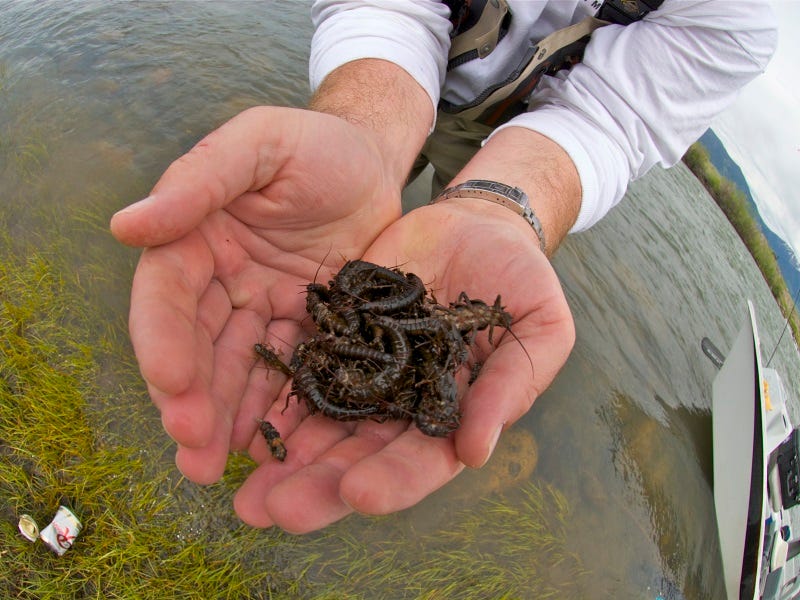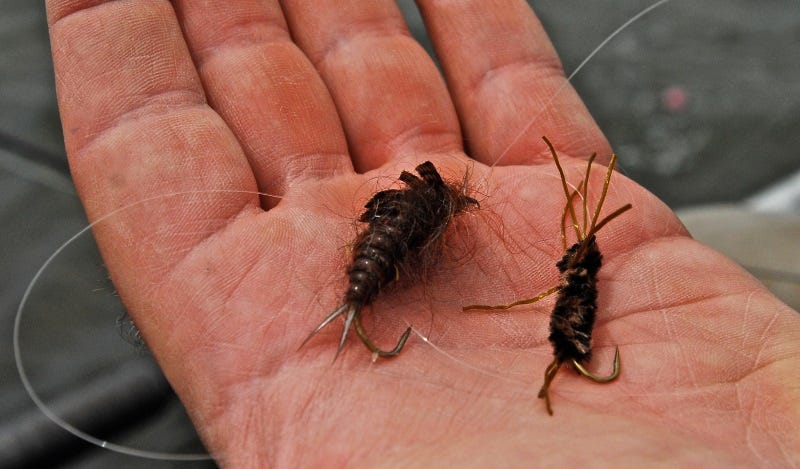Hatch Guide #4: Salmonflies


It's finally spring in Montana, which marks the beginning of a special time for anyone who knows anything about anything . . . and especially if you know about fly-fishing in Big Sky Country and other locals around the Rocky Mountains.
That’s because this is the time when salmonflies, which are three-inch long aquatic insects, get active and begin emerging on dozens of big-name western trout streams, including Montana’s Bitterroot, Big Hole, Madison, and Yellowstone rivers, among many others. And this isn’t any ordinary hatch—because of their size and abundance, even giant trout throw caution to the wind and rise freely to the surface to inhale a mega-meal. Salmonflies are the most anticipated hatch of the year and when anglers hit the hatch perfect—when the adult insects are flying and the trout are crushing imitations of them on the surface—the numbers can add quickly. Think 30 fish days with some brutes ranging to 20 inches or more. That’s the potential with this hatch and that’s why there seem to be more boats on the water than any other time of the year.
Here are the quick and dirty details you’ll need to know to take advantage of this hatch, which begins in May and may run well into July on some streams.
Life Cycle
Salmonflies (Pteronarcys Californica) in the nymphal stage are considered stoneflies and will not be considered a salmonfly until they have become an adult.
Stonefly nymphs require highly oxygenated water to mature, so it isn't a big surprise that they're found in fast-flowing, oxygen-rich streams. For instance, Rock Creek and the Madison River—both boulder-laden streams—offer great habitat, whereas tailwater streams that are silty and run out of a dam, don’t produce these bugs.
During the colder winter months, the stoneflies burrow deep into the bed of the stream to escape from potentially hazardous cold-water conditions. As the water begins to warm in the spring months, the stoneflies emerge from the streambed and cling to the underside of bedrock within highly oxygenated runs and riffles. This is where the stonefly spends most of its life (3-4 years) feeding on algae and other microscopic matter.
As May approaches, mature stoneflies begin their migrations towards the banks. It's during this time that the stoneflies become very susceptible to fish; they have detached from rocks and begin to dead-drift downstream and the fish nail them. They continue to migrate downstream until they make it to a point where they can attach to bedrock only a few feet off the shoreline. Now it is a waiting game for the stonefly.
There are several factors that drive the emergence of stoneflies from the river, but the most important factor is water temperature. Once the water reaches that magical temperature, stonefly nymphs begin to crawl out of the stream onto bankside brush and rocks, where they break through their carapaces and transform into winged adults.
This event is referred to as “shucking.” Once the adult has completely shucked its nymphal layer, it takes refuge in the streamside bushes to dry its body and wings, which can be a one or two-day event. This is why salmonflies require warm, dry weather. When the adults have dried, they begin what I imagine to be their favorite part life–mating. The salmonflies remain on the streamside bushes during this event and are often seen with the smaller sized male on top of the much larger female. The size difference between genders is thought to be an effect of natural selection within the species, which allows the female to carry more eggs. When the female's eggs have been fertilized, she leaves her post on and flies upstream. The flight ranges from one to six miles and this is why the hatch progresses upstream up to 10 miles a day. Once the female has migrated far enough upstream, she lands on the water and deposit her egg-sack in to the stream, while fluttering on the surface. This event marks the end and the beginning of the Pteronarcys’ life cycle. This also marks the moment when these bugs are most vulnerable to trout and the best time to match the insect with big, bushy dry flies.

Techniques
During the nymphal migrations at the end of April and throughout the month of May, standard nymphing techniques in heavy runs and riffles and into the tailouts is the way to go. Popular patterns include RL Stones, H's Rock n' Rollers, Thurminators, Girdle Bugs, Bitch Creeks, and Pats RLs. Make sure that these are fished right on the bottom. If you aren't losing flies, you aren't fishing right.
After the migrations, fishing bigger patterns in the troughs off the banks will treat you right. These patterns include: Yuk Bugs, Jimmy Legs, Pats RL, BH Buggers, and Bitch Creeks.
Once the stoneflies have emerged and shucked into their adult forms, you can throw fluttering stones or low-profile patterns. The fluttering stones work well for imitating egg-laying females, where low-pro patterns imitate dead stones or males that have fallen in the water. Larger, bushier patterns, like fluttering stones, Wike's Big R Bug, and Terrenastys, work well for imitating fluttering female salmonflies. Smaller, trimmed patterns, like Cat Pukes, Rogues, Chernobyls, Widow-makers, and Carnage Stones, work well for imitating dead or fallen stones.
Another technique that is becoming popular is fishing drowned stones. Popular patterns for this technique include trimmed Cat Pukes, Sunken Rogues, Drowned Stones, and sunken King Kongs.
